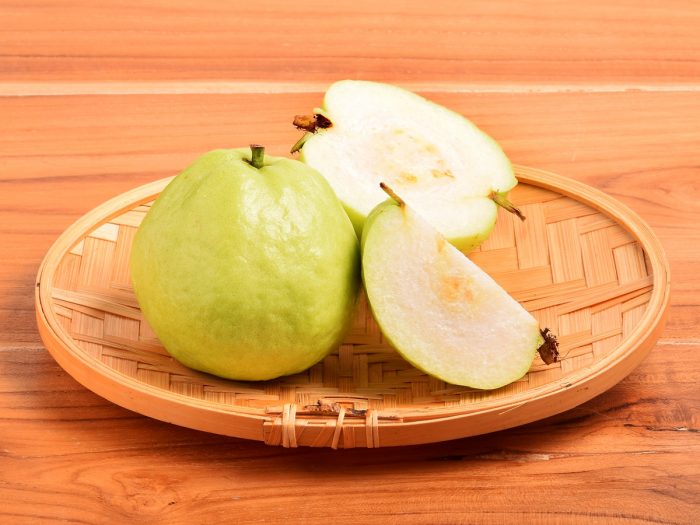Tropical fruits like guavas can be delicious and healthy additions to your diet, but knowing how to eat guava the right way is something that many people still struggle with. Native to Central and South America, as well as parts of Mexico, guavas are wildly popular and refreshing fruits, ranging from 2-5 inches in length, and bearing a slight hint of lemon in their scent. There are a number of different guava varieties, so their flesh ranges in color from white to dark pink, while their flavor can vary between sweet and sour. Due to the versatility and diversity of guavas, they can be used in many different culinary and medicinal applications.
However, also due to the variety of guava types out there, and their “exotic” nature, it can be hard for people to know how to choose or pick the right guava, how the fruits are best prepared, and what the best recipes are that include this unique fruit. [1]
Choosing the Right Guava
Before you can add guava to your favorite fruit smoothie or dessert dish or understand how to eat guava, you need to know how to choose the right guava from the store – or right off the tree! Some of the most important indicators for guavas are softness, color, size, and time of year. As mentioned, there are many different types of guava, but apple guava (Psidium guajava) is the most commonly eaten, and are the cultivar referred to as simply “guava”. [2]

Guavas are rich in antioxidants, vitamin C, potassium, & fiber. Photo Credit: Shutterstock
- Color – While the guava is developing, it will typically be a solid green color, but as it ripens, it will start fading to a light green, with tinges of yellow and even pink. This is when you want to pluck the guava from the tree before it gets flavorless and mushy. [3]
- Smell – When a guava is beginning to ripen, the smell will become much stronger and more noticeable, meaning that you can smell the fruit without holding it directly to your nose. The aroma will almost be musky, and difficult to ignore.
- Texture – Texture – As guavas are developing, they are rather rigid and firm, but when the fruit becomes ripe, it will give a similar appearance to that of a ripened avocado. When the rind can be pushed in slightly, the guava is ready to be harvested! Also, avoid guavas that have large blemishes or bruises. [4]
- Size – Common guavas range in size from 2-6 inches, and will reach full size slightly before ripening. Even if the color looks “ripe”, wait until the guava is a decent size on the branch before picking it.
- Season – Since guavas can grow year-round in tropical climates, there is not a set “harvest season” for these fruits. As a result, don’t pick guavas based on the season, but rather on the other points explained above. [5]
Washing and Cutting Guava
After you have picked or chosen your ideal guava, you need to prepare it properly! Learning how to eat guava can be as challenging as learning how to recognize a ripe one, so be sure to follow the steps below.
- Step 1 – Thoroughly wash your guava, as many people will choose to eat the rind, so you want to be sure it is free of any bacteria, pesticides or fertilizers.
- Step 2 – Pat your guava dry, particularly if you are storing it for a few days in the fridge.
- Step 3 – You can either scoop out the inside of the guava or eat it whole. While some varieties have large seeds that will need to be removed, other types (including apple guava), contain very small seeds.
- Step 4 – Slicing the dense fruit into thin slices is very popular while keeping the rind intact.
- Step 5 – You can dip your guava slices in soy sauce, sprinkle it with salt, or even caramelize it!
Guava Recipe Ideas
The list of potential foods that you can add it to is impressive, which is a good thing since many people don’t know how to eat the guava.
- You can use boil down your guava slices until they are extremely tender and then add them to a variety of cakes, desserts and fruit salads.
- Many people choose to juice guavas and add that juice to barbecue sauce or even cocktails.
- Making glazes and marinades is popular as well, due to the sweetness of many guava varieties.
- Making guava jello is popular with parents, or you can sauté the fruit to make a warm caramelized syrup that is an excellent topping for pancakes or waffles.
- Since this fruit is complemented well by savory flavors, many people also include guavas in meat dishes as a sweet side.
- For those who like to can their fruits, you can make guava jelly and jam in a few simple steps. Learning how to eat guava in new ways is not only exciting and delicious, but also healthy!
